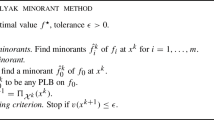Abstract
A standard quadratic optimization problem (StQP) consists in minimizing a quadratic form over a simplex. Among the problems which can be transformed into a StQP are the general quadratic problem over a polytope, and the maximum clique problem in a graph. In this paper we present several new polynomial-time bounds for StQP ranging from very simple and cheap ones to more complex and tight constructions. The main tools employed in the conception and analysis of most bounds are Semidefinite Programming and decomposition of the objective function into a sum of two quadratic functions, each of which is easy to minimize. We provide a complete diagram of the dominance, incomparability, or equivalence relations among the bounds proposed in this and in previous works. In particular, we show that one of our new bounds dominates all the others. Furthermore, a specialization of such bound dominates Schrijver’s improvement of Lovász’s θ function bound for the maximum size of a clique in a graph.
Similar content being viewed by others
References
Anstreicher K. and Burer S. (2005). D.C. Versus copositive bounds for standard QP. J. Glob. Optim. 33: 299–312
Bomze I.M. (1998). On standard quadratic optimization problems. J. Glob. Optim. 13: 369–387
Bomze I.M. (2000). Copositivity aspects of standard quadratic optimization problems. In: Dockner, E., Hartl, R., Luptacik, M. and Sorger, G. (eds) Dynamics, Optimization and Economic Analysis., pp 1–11. Physica, Heidelberg
Bomze I.M. (2002). Branch-and-bound approaches to standard quadratic optimization problems. J. Glob. Optim. 22: 17–37
Bomze I.M., Dür M., de Klerk E., Quist A., Roos C. and Terlaky T. (2000). On copositive programming and standard quadratic optimization problems. J. Glob. Optim. 18: 301–320
Bomze I.M. and de Klerk E. (2002). Solving standard quadratic optimization problems via linear, semidefinite and copositive programming. J. Glob. Optim. 24: 163–185
Bomze I.M. and Locatelli M. (2004). Undominated d.c. decompositions of quadratic functions and applications to branch-and-bound approaches. Comput. Optim. Appl. 28(2): 227–245
Bomze, I.M., Locatelli, M., Tardella, F.: Efficient and cheap bounds for (Standard) Quadratic Optimization, Technical Report dis tr 2005/2010, Dipartimento di Informatica e Sistemistica “Antonio Ruberti”, Universitá degli Studi di Roma “La Sapienza”, available at http://www.optimization-online.org/DB_HTML/2005/07/1176.html (2005)
Boyd S. and Vandenberghe L. (2004). Convex Optimization. Cambridge University Press, Cambridge
Laurent M., Parrillo P.A. and Klerk E. (2006). A PTAS for the minimization of polynomials of fixed degree over the simplex. Theor. Comp. Sci. 361: 210–225
de Klerk E. and Pasechnik D.V. (2002). Approximation of the stability number of a graph via copositive programming. SIAM J. Optim. 12: 875–892
Diananda P.H. (1967). On non-negative forms in real variables some or all of which are non-negative. Proc. Camb. Philos. Soc. 58: 17–25
Dür M. (2002). A class of problems where dual bounds beat underestimation bounds. J. Glob. Optim. 22: 49–57
Falk J. (1969). Lagrange multipliers and nonconvex programs. SIAM J. Control 7: 312–321
Frank M. and Wolfe P. (1956). An algorithm for quadratic programming. Naval Res. Logist. Q. 3: 95–110
Gibbons L.E., Hearn D.W., Pardalos P.M. and Ramana M.V. (1997). Continuous characterizations of the maximum clique problem. Math. Oper. Res. 22: 754–768
Gower J.C. (1985). Properties of Euclidean and non-Euclidean distance matrices. Linear Algebra Appl. 67: 81–97
Horst R. and Tuy H. (1990). Global Optimization: Deterministic Approaches. Springer, Berlin
Ibaraki T. and Katoh N. (1988). Resource Allocation Problems: Algorithmic Approaches. MIT Press, Cambridge
Lasserre J.B. (2001). Global optimization with polynomials and the problem of moments. SIAM J. Optim. 11: 796–817
Lemaréchal, C., Oustry, F.: Semidefinite relaxations and Lagranian duality with application to combinatorial optimization, INRIA research report, vol. 3710 (1999)
Markowitz H.M. (1952). Portfolio selection. J. Finance 7: 77–91
Markowitz H.M. (1995). The general mean-variance portfolio selection problem. In: Howison, S.D., Kelly, F.P. and Wilmott, P. (eds) Mathematical Models in Finance, vol. 93–99., pp. Chapman & Hall, London
Motzkin T.S. and Straus E.G. (1965). Maxima for graphs and a new proof of a theorem of Turán. Can. J. Math. 17: 533–540
Nesterov, Y.E.: Global Quadratic Optimization on the Sets with Simplex Structure, Discussion paper 9915, CORE. Catholic University of Louvain, Belgium (1999)
Nowak I. (1999). A new semidefinite programming bound for indefinite quadratic forms over a simplex. J. Glob. Optim. 14: 357–364
Pena J., Vera J. and Zuluaga L. (2007). Computing the stability number of a graph via linear and semidefinite programming. SIAM J. Optim. 18: 87–105
Rockafellar R.T. (1970). Convex analysis. Princeton University Press, Princeton
Schrijver A. (1979). A comparison of the Delsarte and Lovász bounds. IEEE Trans. Inf. Theory 25: 425–429
Sahinidis N.V. and Tawarmalani M. (2002). Convex extensions and envelopes of lower semi-continuous functions. Math. Prog. 93: 247–263
Tardella F. (1990). On the equivalence between some discrete and continuous optimization problems. Ann. Oper. Res. 25: 291–300
Tardella F. (2004). Connections between continuous and combinatorial optimization problems through an extension of the fundamental theorem of linear programming. Electron. Notes Discret. Math. 17: 257–262
Tuy, H.: A general deterministic approach to global optimization via d.c. programming. In: Fermat days 85: Mathematics for optimization, vol. 129. North-Holland Math. Stud., Toulouse/France, pp. 273–303 (1985)
Author information
Authors and Affiliations
Corresponding author
Rights and permissions
About this article
Cite this article
Bomze, I.M., Locatelli, M. & Tardella, F. New and old bounds for standard quadratic optimization: dominance, equivalence and incomparability. Math. Program. 115, 31–64 (2008). https://doi.org/10.1007/s10107-007-0138-0
Received:
Accepted:
Published:
Issue Date:
DOI: https://doi.org/10.1007/s10107-007-0138-0
Keywords
- Standard quadratic optimization
- Semidefinite programming
- Quadratic programming
- Maximum clique
- Resource allocation




